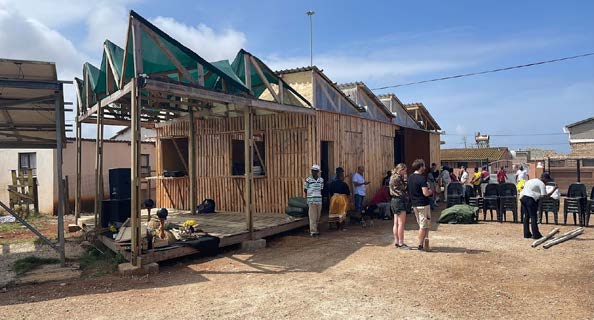We are publishing this article in the feature on the dysfunctional state as an illustration of one response to that dysfunctionality – set up your own, local, socially-owned project. In this case to produce electricity. The story shows how, even in this kind of project, the dysfunctional state is an obstacle. A lack of a coherent strategy means that the state becomes an obstacle to socially useful projects. (Editor).

THE TRANSITION TOWNSHIP project is an action research project involving residents of KwaZakhele township in Nelson Mandela Bay. It explores models of cooperative production of energy, food sovereignty and circular economy. The project was conceived, some seven years ago, to explore models for a just transition from fossil fuel. The idea was that residents of a working-class township would produce electricity from PV solar and sell it to the municipal grid. The concept had support from the municipality. A pilot project was set up on one “gap tap” (public open space) in KwaZakhele, with a neighbourhood cooperative and a small 5Kw PV solar array. The core assumption of the project was that the municipality would buy the electricity.
Feed-in tariff?
A feed-in tariff (FIT) seemed to be the best mechanism for residents to benefit from producing PV solar electricity. The Nelson Mandela Bay municipality had some years before introduced an innovative system to encourage homeowners to install PV solar and remain connected to the grid. If they produced more electricity than they used, the municipality would not pay them for it, but would credit their municipal account. This system is no longer in operation, and there is no feed-in tariff to enable households to be paid for their surplus, as there are in many other countries of the world.
The Saltuba Cooperative set up the pilot PV solar array in October 2019. It was connected to the grid and fed approximately R20,000 worth of electricity to the municipality. However, Saltuba could not be paid for this. This caused understandable disappointment; expectations of income were not met.
But the pilot was hailed in 2020 as an innovative model. So the municipality promised that by July 2021 the participating households would be able to get financial benefit from the project. Metro spokesperson Mamela Ndamase explained that the City had to apply to NERSA for a FIT. Both NERSA and the Council had to approve. Then residents would be able to get credit on their electricity accounts for what they feed into the grid. But still no direct payment.
The wheeling option
Meanwhile, Transition Township explored the Wheeling Tariff (WIT) option. This uses the municipal grid to “wheel” (transmit) the electricity, which is bought by a third party. This can be either an energy trader or an “end user” (which may be a business which uses the same grid). The third party pays a “wheeling tariff” or fee to the municipality for the use of the grid. It buys the electricity from the producer (the Saltuba Cooperative in this case) for an agreed amount. If it is an energy trader, it sells it on to the end user.
We approached a renewable energy trader company which had a licence to wheel electricity. But they were not interested as the pilot was below their threshold of 25kW. So they didn’t consider it viable. Then we encountered another hurdle. In order to wheel the electricity, Saltuba needed to open a municipal account to obtain a smart meter. But the land is owned by the municipality, not by Saltuba. So Saltuba had to apply for a lease.
Inverter and battery
By December 2022 there was still no progress with selling the electricity. So we put in place an alternative, interim measure: an inverter and lithium-ion battery. This would allow Saltuba to store the electricity and use it to run a waste-recycling hub as a self-sustaining community facility. This is called “off-grid renewable energy”; the electricity that is produced is not fed into the municipal grid. As well as the waste recycling business, this model would provide lights, plug points and internet access to allow students to study for exams, even under load-shedding. And residents could create an internet café and a community kitchen.
The new structure was launched to community acclaim, with electricity being used to power lights, music and a PA system for the launch. Sadly, shortly after the launch, the battery and digital scale for weighing recycling were stolen. The project team will only be able to replace the equipment and expand the generation capacity once there is a risk management plan in place.
A new energy environment
Meanwhile, the national energy environment began to change. In October 2021 the Electricity Regulation Act was amended. It allowed small producers of renewable energy to sell up to 100MW of electricity without having to apply for a licence to do so. Then, in March 2023, a tax rebate was introduced to encourage South African taxpayers to install solar panels on their homes.
Private players in the renewable energy sector are, of course, delighted with these developments, and are planning to take advantage of them. But the tax rebate for households putting up PV panels is not going to be accessible to most township or working-class households. Only more affluent households and businesses are going to be able to take advantage of this.
Transition Township has also had trouble in convincing both the municipality and the residents that they would all benefit from the production and sale of electricity by township cooperatives. The municipality mistakenly thought they would lose revenue. Most households in Kwazakhele qualify for Assistance to the Poor (ATTP) which involves an allocation of free electricity. Some members of the cooperative reported that they were told by municipal officials that they were no longer eligible for ATTP as they were “owners of a business”. This is despite the fact that the business, Saltuba Cooperative, had not yet generated any income. This led to some members wanting to leave the cooperative. But the new Ward Councillor for Ward 22 has assured Saltuba that this policy has been reversed and that members of the cooperative will be able to receive ATTP.

With the new regulations, the municipal electricity department has agreed in principle for Saltuba to be a pilot project for community-owned renewable energy; we are hoping that this will soon be possible, and that the Saltuba RE pilot can be replicated on other gap-taps in Kwazakhele.
How municipal revenue would be affected, how Eskom would be affected, and whether the grid could cope with inputs from many township producers – all these are to be tested through this Pilot. The exemption from the licence does not, however, mean that households can sell electricity to municipalities.
They are bound by the MFMA (Municipal Finance Management Act) to put any purchase out to competitive tender. As the Nelson Mandela Bay municipality spokesman Mamela Ndamase explained, “National Treasury will need to exempt/ suspend supply chain regulations to allow procurement from residents”.
Other models
There are some other interesting proposals regarding renewable energy feed-in. Most are private-sector-led and privately owned. One is the Frankfort (Free State) company, Rural Maintenance. It is working with PV solar “sunfarms” which are planning to do agrovoltaics (growing vegetables as well as producing electricity from PV solar).
The agriculture has not yet been able to benefit from the PV solar. So they have been feeding electricity from the solar farm to the Mafube municipality, with community buy-in. This has enabled the Mafube municipality to meet residents’ electricity needs. But now Eskom has taken them to court for not implementing of load-shedding.
Alex Lenferna, from the Climate Justice Coalition, has argued that the agrovoltaics model could be combined with land redistribution to fulfil the “just energy transition” in rural areas. This would create more equitable land distribution while producing both food and energy.
The Transition Township model uses existing public land and household cooperatives in a model of community-owned renewable energy in urban townships. However, both these models are in the future: it would seem that while socially-owned renewable energy is a “no-brainer” in terms of the just transition, it is more difficult to realise than anticipated.
JET-IP financing may assist with infrastructure support, such as expanding the grid to accommodate many small producers. The way forward is clearly through distributed production of renewable energy, the cost of which has decreased rapidly. But it is not clear who will benefit from this energy transition. Will it be a “just transition”? The argument of Transition Township is that renewable energy – in particular, PV solar – allows for a distribution of the assets for energy production; and that these assets can be socially or community owned. But the failure of the state to coordinate and implement a coherent strategy means that it is not proving so easy to implement the model in practice.
Janet Cherry is an ecosocialist activist and Professor of Development Studies at Nelson Mandela University in Gqeberha.
The post CORE, SORE OR SOCIALISM? REALISING THE JUST ENERGY TRANSITION THROUGH NEW FORMS OF OWNERSHIP appeared first on Amandla.






